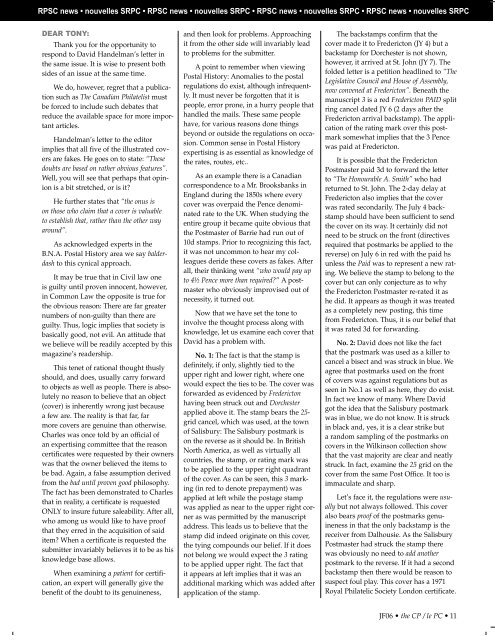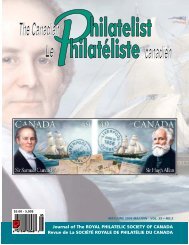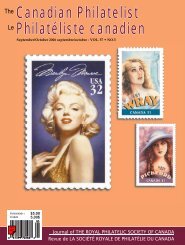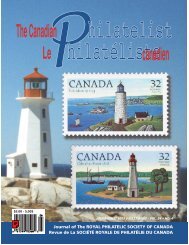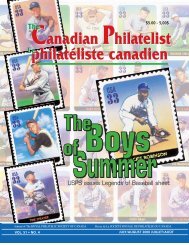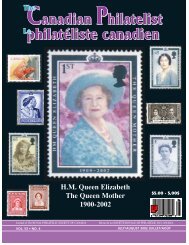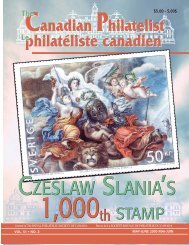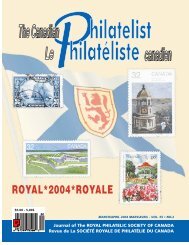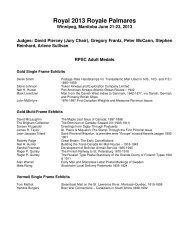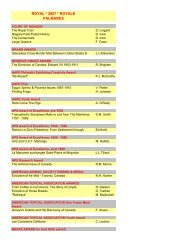GREENWOOD STAMP COMPANY â Since 1962 - The Royal ...
GREENWOOD STAMP COMPANY â Since 1962 - The Royal ...
GREENWOOD STAMP COMPANY â Since 1962 - The Royal ...
You also want an ePaper? Increase the reach of your titles
YUMPU automatically turns print PDFs into web optimized ePapers that Google loves.
RPSC news • nouvelles SRPC • RPSC news • nouvelles SRPC • RPSC news • nouvelles SRPC • RPSC news • nouvelles SRPC<br />
DEAR TONY:<br />
Thank you for the opportunity to<br />
respond to David Handelman’s letter in<br />
the same issue. It is wise to present both<br />
sides of an issue at the same time.<br />
We do, however, regret that a publication<br />
such as <strong>The</strong> Canadian Philatelist must<br />
be forced to include such debates that<br />
reduce the available space for more important<br />
articles.<br />
Handelman’s letter to the editor<br />
implies that all five of the illustrated covers<br />
are fakes. He goes on to state: “<strong>The</strong>se<br />
doubts are based on rather obvious features”.<br />
Well, you will see that perhaps that opinion<br />
is a bit stretched, or is it?<br />
He further states that “the onus is<br />
on those who claim that a cover is valuable<br />
to establish that, rather than the other way<br />
around”.<br />
As acknowledged experts in the<br />
B.N.A. Postal History area we say balderdash<br />
to this cynical approach.<br />
It may be true that in Civil law one<br />
is guilty until proven innocent, however,<br />
in Common Law the opposite is true for<br />
the obvious reason: <strong>The</strong>re are far greater<br />
numbers of non-guilty than there are<br />
guilty. Thus, logic implies that society is<br />
basically good, not evil. An attitude that<br />
we believe will be readily accepted by this<br />
magazine’s readership.<br />
This tenet of rational thought thusly<br />
should, and does, usually carry forward<br />
to objects as well as people. <strong>The</strong>re is absolutely<br />
no reason to believe that an object<br />
(cover) is inherently wrong just because<br />
a few are. <strong>The</strong> reality is that far, far<br />
more covers are genuine than otherwise.<br />
Charles was once told by an official of<br />
an expertising committee that the reason<br />
certificates were requested by their owners<br />
was that the owner believed the items to<br />
be bad. Again, a false assumption derived<br />
from the bad until proven good philosophy.<br />
<strong>The</strong> fact has been demonstrated to Charles<br />
that in reality, a certificate is requested<br />
ONLY to insure future saleability. After all,<br />
who among us would like to have proof<br />
that they erred in the acquisition of said<br />
item? When a certificate is requested the<br />
submitter invariably believes it to be as his<br />
knowledge base allows.<br />
When examining a patient for certification,<br />
an expert will generally give the<br />
benefit of the doubt to its genuineness,<br />
and then look for problems. Approaching<br />
it from the other side will invariably lead<br />
to problems for the submitter.<br />
A point to remember when viewing<br />
Postal History: Anomalies to the postal<br />
regulations do exist, although infrequently.<br />
It must never be forgotten that it is<br />
people, error prone, in a hurry people that<br />
handled the mails. <strong>The</strong>se same people<br />
have, for various reasons done things<br />
beyond or outside the regulations on occasion.<br />
Common sense in Postal History<br />
expertising is as essential as knowledge of<br />
the rates, routes, etc..<br />
As an example there is a Canadian<br />
correspondence to a Mr. Brooksbanks in<br />
England during the 1850s where every<br />
cover was overpaid the Pence denominated<br />
rate to the UK. When studying the<br />
entire group it became quite obvious that<br />
the Postmaster of Barrie had run out of<br />
10d stamps. Prior to recognizing this fact,<br />
it was not uncommon to hear my colleagues<br />
deride these covers as fakes. After<br />
all, their thinking went “who would pay up<br />
to 4½ Pence more than required?” A postmaster<br />
who obviously improvised out of<br />
necessity, it turned out.<br />
Now that we have set the tone to<br />
involve the thought process along with<br />
knowledge, let us examine each cover that<br />
David has a problem with.<br />
No. 1: <strong>The</strong> fact is that the stamp is<br />
definitely, if only, slightly tied to the<br />
upper right and lower right, where one<br />
would expect the ties to be. <strong>The</strong> cover was<br />
forwarded as evidenced by Fredericton<br />
having been struck out and Dorchester<br />
applied above it. <strong>The</strong> stamp bears the 25-<br />
grid cancel, which was used, at the town<br />
of Salisbury: <strong>The</strong> Salisbury postmark is<br />
on the reverse as it should be. In British<br />
North America, as well as virtually all<br />
countries, the stamp, or rating mark was<br />
to be applied to the upper right quadrant<br />
of the cover. As can be seen, this 3 marking<br />
(in red to denote prepayment) was<br />
applied at left while the postage stamp<br />
was applied as near to the upper right corner<br />
as was permitted by the manuscript<br />
address. This leads us to believe that the<br />
stamp did indeed originate on this cover,<br />
the tying compounds our belief. If it does<br />
not belong we would expect the 3 rating<br />
to be applied upper right. <strong>The</strong> fact that<br />
it appears at left implies that it was an<br />
additional marking which was added after<br />
application of the stamp.<br />
<strong>The</strong> backstamps confirm that the<br />
cover made it to Fredericton (JY 4) but a<br />
backstamp for Dorchester is not shown,<br />
however, it arrived at St. John (JY 7). <strong>The</strong><br />
folded letter is a petition headlined to “<strong>The</strong><br />
Legislative Council and House of Assembly,<br />
now convened at Fredericton”. Beneath the<br />
manuscript 3 is a red Fredericton PAID split<br />
ring cancel dated JY 6 (2 days after the<br />
Fredericton arrival backstamp). <strong>The</strong> application<br />
of the rating mark over this postmark<br />
somewhat implies that the 3 Pence<br />
was paid at Fredericton.<br />
It is possible that the Fredericton<br />
Postmaster paid 3d to forward the letter<br />
to “<strong>The</strong> Honourable A. Smith” who had<br />
returned to St. John. <strong>The</strong> 2-day delay at<br />
Fredericton also implies that the cover<br />
was rated secondarily. <strong>The</strong> July 4 backstamp<br />
should have been sufficient to send<br />
the cover on its way. It certainly did not<br />
need to be struck on the front (directives<br />
required that postmarks be applied to the<br />
reverse) on July 6 in red with the paid hs<br />
unless the Paid was to represent a new rating.<br />
We believe the stamp to belong to the<br />
cover but can only conjecture as to why<br />
the Fredericton Postmaster re-rated it as<br />
he did. It appears as though it was treated<br />
as a completely new posting, this time<br />
from Fredericton. Thus, it is our belief that<br />
it was rated 3d for forwarding.<br />
No. 2: David does not like the fact<br />
that the postmark was used as a killer to<br />
cancel a bisect and was struck in blue. We<br />
agree that postmarks used on the front<br />
of covers was against regulations but as<br />
seen in No.1 as well as here, they do exist.<br />
In fact we know of many. Where David<br />
got the idea that the Salisbury postmark<br />
was in blue, we do not know. It is struck<br />
in black and, yes, it is a clear strike but<br />
a random sampling of the postmarks on<br />
covers in the Wilkinson collection show<br />
that the vast majority are clear and neatly<br />
struck. In fact, examine the 25 grid on the<br />
cover from the same Post Office. It too is<br />
immaculate and sharp.<br />
Let’s face it, the regulations were usually<br />
but not always followed. This cover<br />
also bears proof of the postmarks genuineness<br />
in that the only backstamp is the<br />
receiver from Dalhousie. As the Salisbury<br />
Postmaster had struck the stamp there<br />
was obviously no need to add another<br />
postmark to the reverse. If it had a second<br />
backstamp then there would be reason to<br />
suspect foul play. This cover has a 1971<br />
<strong>Royal</strong> Philatelic Society London certificate.<br />
JF06 • the CP / le PC • 11


